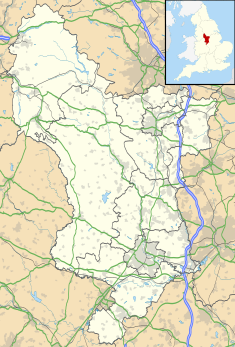Long Eaton Town Hall
| Long Eaton Town Hall | |
|---|---|
 Long Eaton Town Hall | |
| Location | Derby Road, Long Eaton |
| Coordinates | 52°54′02″N 1°16′20″W / 52.9005°N 1.2722°W |
| OS grid reference | SK4905233917 |
| Built | 1778 |
| Architect | Joseph Pickford |
| Architectural style(s) | Palladian style |
Listed Building – Grade II* | |
| Official name | The Hall, Derby Road |
| Designated | 22 October 1962 |
| Reference no. | 1204191[1] |
Long Eaton Town Hall is a municipal building in Derby Road, Long Eaton, Derbyshire, England. The town hall, which currently serves as one of two meeting places of Erewash Borough Council, is a Grade II* listed building.[1]
History
The building was commissioned by a local gentleman farmer, John Howitt: the site he selected had been open pasture and the building became known as Long Eaton Hall.[2] It was designed by Joseph Pickford in the Palladian style, built in red brick with sandstone dressings and was completed in 1778.[1][2]
The design involved a symmetrical main frontage with three bays facing onto Derby Road; the central bay, which slightly projected forward, featured a doorway with a fanlight on the ground floor flanked by Doric order columns, narrow sash windows and Doric order pilasters all supporting an entablature and a pediment. The stone for the door case was quarried at Horston Castle.[3] The first and second floors of the central bay were fenestrated with sash windows with architraves while the outer bays were fenestrated with sash windows surmounted by gauged brickwork. At roof level there was a modillioned cornice and a central pediment. Internally, the principal rooms were the reception rooms, one of which contained a fine marble fireplace, inlaid with Blue John stone and designed by the prisons architect, George Moneypenny.[4] The rooms on the upper floors were accessed by a main staircase which led to a first floor landing with fine wooden balusters.[1]
The building passed down the Howitt family until it was acquired by the Reverend Francis Gawthorne for use as a vicarage in 1839 and then bought by the lace manufacturers, Joseph and Thomas Fletcher, in 1873.[5][6] Following significant population growth, largely associated with the machine factory industry, the area became an urban district in 1894.[7] The new council, which initially held its meetings in the Blue Bell Inn,[8] acquired Long Eaton Hall in 1921.[9] At that time, the council also inherited some 90 paintings which Charles Sydney Howitt had left to his wife during her lifetime and to the council thereafter: many of these remained in situ on the walls of the building.[10] A bronze plaque, intended to commemorate the lives of soldiers from the Sherwood Foresters who died during the First World War, was attached to the front wall of the building.[11] The urban district council also acquired a nearby house at 1 Nottingham Road, which was given the name Town Hall and used as the council's meeting place, with Long Eaton Hall being used as offices.[12]
Long Eaton Hall continued to serve as the offices of the urban district council for much of the 20th century.[13] Following local government re-organisation in 1974,[14] the newly formed authority, Erewash Borough Council, split its operations between Ilkeston Town Hall and Long Eaton. A large extension was added to Long Eaton Hall, being completed in 1991, comprising a modern office block with a curved aluminium and glass façade to the west of the original building.[15] The enlarged facility was officially opened by the Minister of State for Local Government and Inner Cities, Michael Portillo, on 25 April 1991.[5][16] The enlarged building was renamed "Town Hall", and the old town hall at 1 Nottingham Road was subsequently sold.[17][18]
See also
References
- ^ a b c d Historic England. "The Hall, Derby Road (Grade II*) (1204191)". National Heritage List for England. Retrieved 19 August 2023.
- ^ a b "The Hall, Long Eaton". Derbyshire Historic Environment Record. Retrieved 25 December 2021.
- ^ Saunders, Edward (1993). Joseph Pickford of Derby. Sutton Publishing. p. 174. ISBN 978-0750903806.
- ^ Craven, Maxwell (1996). John Whitehurst of Derby: Clockmaker and Scientist, 1713-88. Mayfield Books. p. 76. ISBN 978-0952327035.
- ^ a b "Long Eaton". The Long Eaton & Sawley Archive. Retrieved 25 December 2021.
- ^ Godfrey, John Thomas (1884). The History of the Parish and Priory of Lenton in the County of Nottinghamshire. Bemrose and Sons.
- ^ "Long Eaton UD". Vision of Britain. Retrieved 25 December 2021.
- ^ Derbyshire Guide. Derbyshire Countryside. 1936. p. 303.
- ^ "Long Eaton: The Town Walk". Ilkeston Cam. Retrieved 25 December 2021.
- ^ Meijer, Fred G. (2005). Dutch and Flemish Still-Life Paintings: bequeathed by Daisy Linda Ward (PDF). Waanders. ISBN 978-9040088025.
- ^ "Sherwood Foresters". Imperial War Museum. Retrieved 25 December 2021.
- ^ "Unique heritage worth preserving". Nottingham Recorder. 23 March 1995. p. 20. Retrieved 24 July 2023.
- ^ "No. 45950". The London Gazette. 10 April 1973. p. 4631.
- ^ Local Government Act 1972. 1972 c.70. The Stationery Office Ltd. 1997. ISBN 0-10-547072-4.
- ^ "Long Eaton ‒ Past, Present and Future". Derbyshire Life. 3 February 2014. Retrieved 25 December 2021.
- ^ "New town hall wins VIP praise". Long Eaton Advertiser. 3 May 1991. p. 3. Retrieved 24 July 2023.
- ^ "Buyer sought for Town Hall: Advice is not to demolish". Long Eaton Advertiser. 28 September 1990. p. 9. Retrieved 24 July 2023.
- ^ "Contact the council". Erewash Borough Council. Retrieved 25 December 2021.

